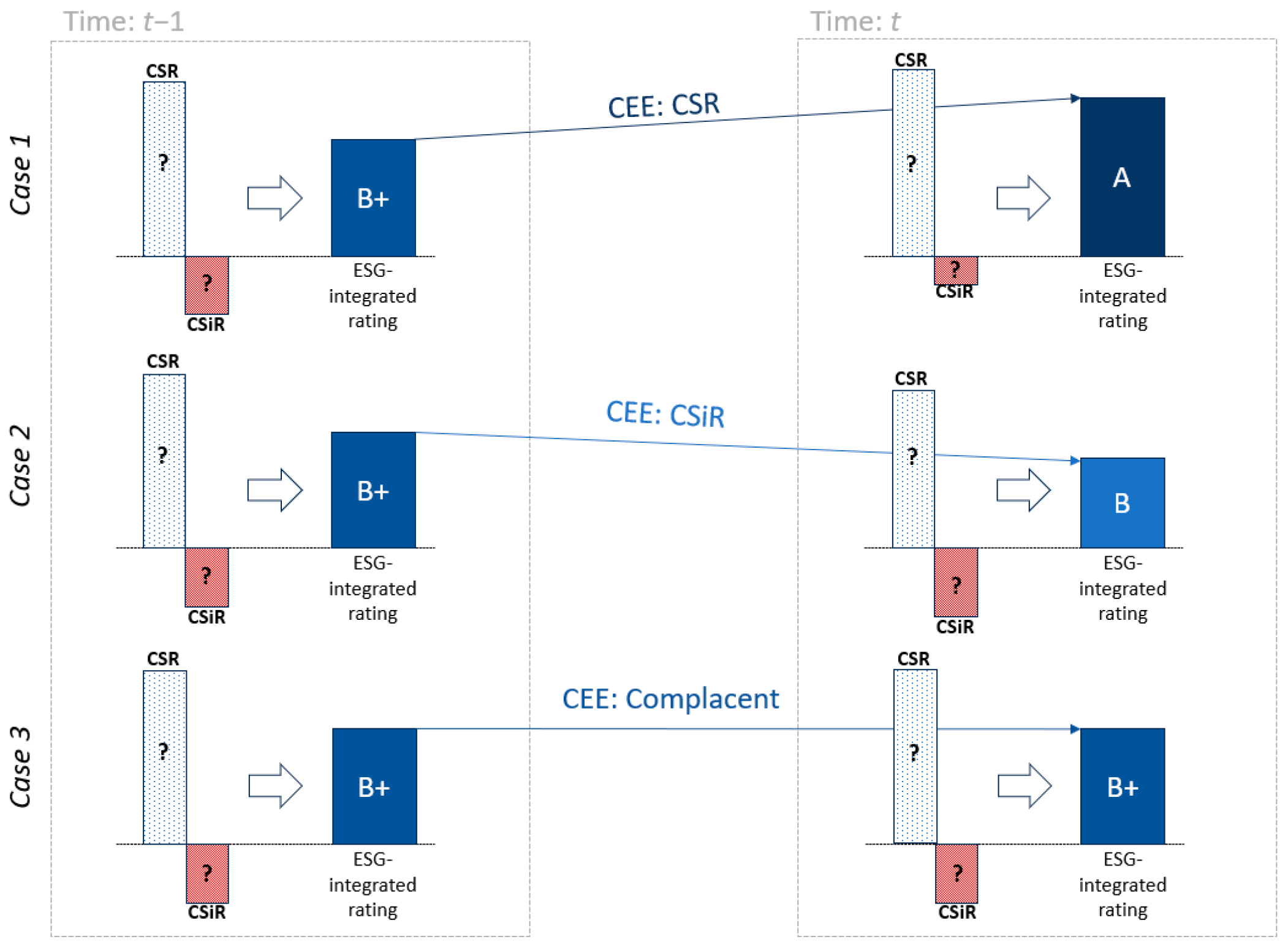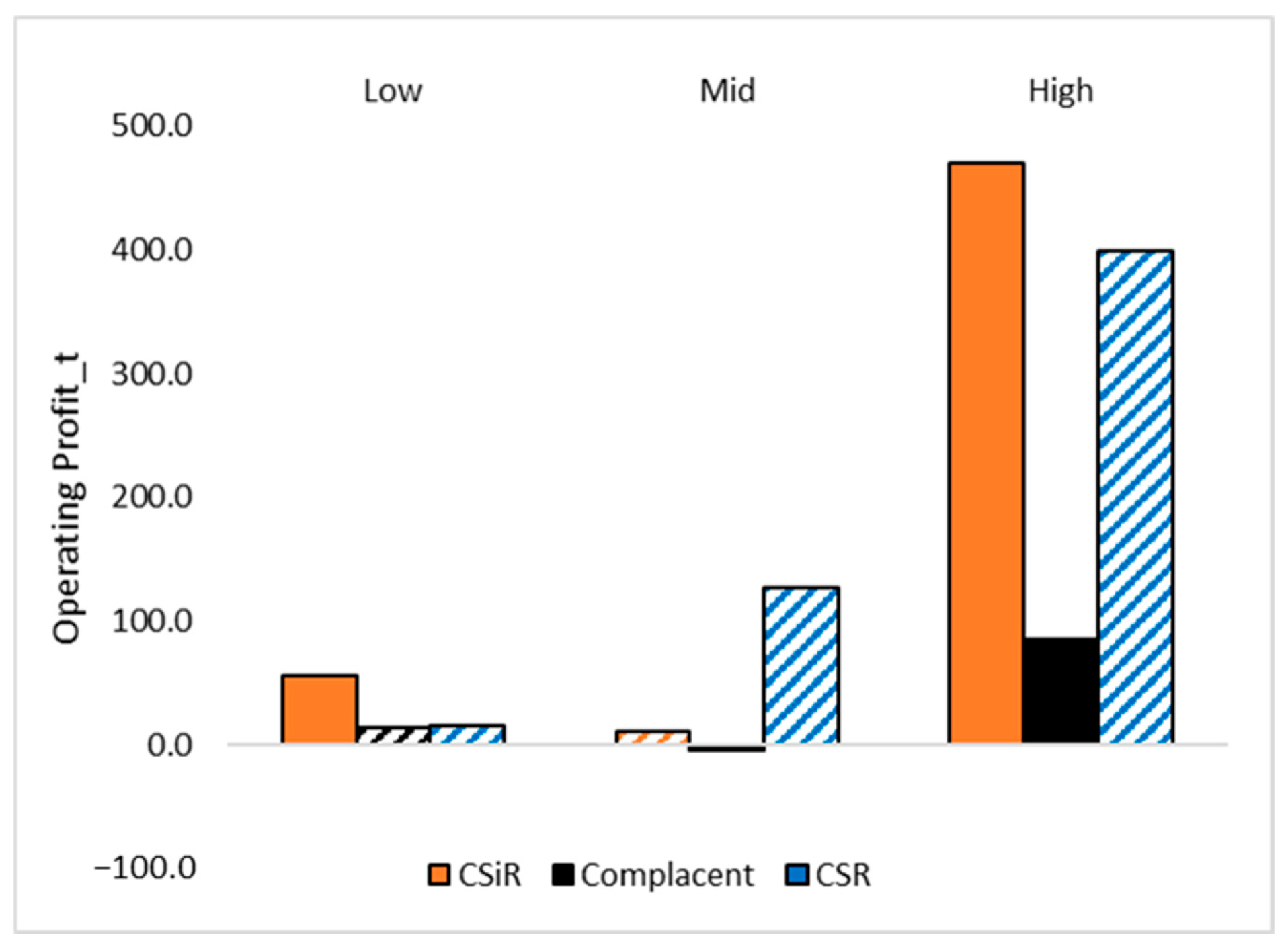3.1. Sample and Data
In this study, the ESG rating data and financial performance data of Korean listed companies are used for analysis. Many prior studies utilize US-based KLD data; however, this study uses data from Korean listed companies to extend the generalizability of previous findings and to identify country-specific differences in ethical and sustainability practices. A sample of companies listed on the Korean stock market over a consecutive twelve-year period is used, which allows for a robust sample size over an adequate period of time. However, proper caution is recommended when generalizing the results, as the nature of the sample generally tends toward larger and more mature companies.
First, the data from the Korea Corporate Governance Service (KCGS) is used for the ESG evaluation rating data of listed companies in Korea. KCGS has evaluated the performance of Korean listed companies in three areas annually since 2012: environmental management (E), socially responsible management (S), and governance (G). The KCGS announces individual ratings for each area and the integrated ESG rating annually. Through this, it contributes to establishing Korea’s ESG-related system by encouraging companies to faithfully carry out their responsibilities to stakeholders and by providing stakeholders with information for decision-making.
As shown in
Table 1, the number of companies with published ESG-integrated ratings from KCGS has steadily increased, from 797 in 2012 to 987 in 2023. This study analyses 384 manufacturing companies with integrated ratings that span across a consecutive twelve-year period without missing values. Given that ESG pressures and evaluation criteria vary significantly across industries, restricting the sample to the manufacturing sector enhances internal validity by mitigating heterogeneity across sectors. Manufacturing firms are also the most representative and comparable group in the KCGS dataset, ensuring that sectoral differences do not distort the results. Thus, the focus on manufacturing minimizes heterogeneity rather than introducing bias.
Since the analysis measures the change in evaluation grade from time point t − 1 to time point t, companies with missing values during any year are excluded because missingness may introduce period-specific bias. Therefore, the analysis suitably estimates the effects of ratings via eleven repeated measures for each company across the twelve-year period.
Specifically, the financial performance data of the sampled 384 companies is analyzed through the DataGuide system provided by FnGuide in South Korea. Due to the characteristic of measuring the change between time points t − 1 and t, two years are required per observation, thereby creating a total of eleven periods (e.g., period2012,2013, period2013,2014, ···, period2022,2023). Therefore, a final sample of 384 companies represented by 4224 data points is used for analysis.
3.2. Operational Definition and Measurement of Variables
Corporate ethical levels (CEL) are obtained from integrated ESG ratings provided by the Korea Corporate Governance Service (KCGS) and are calculated via an absolute evaluation method. More specifically, the ESG-integrated rating of KCGS is calculated by summing the scores for each ESG area by adding points for CSR activities and deducting points for CSiR incidents, although the exact point system is not publicly disclosed. Therefore, only the categorical grades for each ESG category and the total ESG-integrated ratings are available to the public. The ESG-integrated grades are used to represent the corporate ethical level. Based on the meaning and definition of the KCGS ratings, as shown in
Table 2, the corporate ethical level at time
t − 1 is classified as High, Mid, or Low.
The corporate ethical efforts (CEE) are derived from the change in the integrated ESG ratings between
t − 1 and
t. A company’s ethical efforts are measured as CSR, CSiR, or Complacent depending on the direction of ESG rating change.
Figure 1 presents the measurement standards used for defining corporate ethical efforts. Corporate ethical efforts at time
t are considered “CSR” if the ESG-integrated rating of the individual company at time
t has increased compared to time
t − 1. The efforts are considered “CSiR” if the rating has decreased compared to time
t − 1 and are “Complacent” if the rating at time
t is the same as time
t − 1. Conceptually, if the evaluation grade of an individual company at time
t has risen compared to the previously reported time point
t − 1, it can be seen as having a relatively strong CSR propensity. Conversely, if the evaluation grade of an individual company at time
t has decreased compared to time
t − 1, it can be judged that the CSiR propensity has become stronger. Therefore, the corporate ethical efforts (CEE) are considered as “CSR” when the total ESG evaluation grade is upgraded from time
t − 1 to time
t, “CSiR” when the total ESG evaluation grade is downgraded from time
t − 1 to time
t, and “Complacent” when the total ESG grade is maintained between time
t − 1 and time
t. Defining corporate ethical efforts in this manner is summarized in
Figure 1.
Due to autocorrelation between a company’s ESG evaluation grade at time
t and
t − 1, the company’s ethical efforts are measured dynamically over period
t−1,t to reflect relative change. Following Ormiston and Wong [
4], who used prior CSR and CSiR ratings as lagged controls in modeling subsequent ratings, this study also considers the previous CSR level to control for temporal dependence in ESG performance.
When measuring CEE, the CEL may affect the impact of CEE on CFP. For example, if a company’s ESG rating rises from D at time
t − 1 to C at time
t and from A at time
t − 1 to A+ at time
t, the company’s ethical efforts are defined as CSR in both cases, and the question arises as to whether these cases should be viewed as equivalent. Considering this issue, in this study, the absolute meaning of the ESG evaluation rating at the time point
t − 1 was measured as the corporate ethical level; therefore, this difference in corporate ethical level is controlled for. Since the impact on CFP of the company’s ethical efforts at period
t−1,t may vary depending on the company’s ethical level at time
t − 1, a 3x3 interaction variable is constructed, as shown in
Table 3, to analyze the interaction effect.
The operating profit over periodt−1,t is represented in financial statements at time point t, and is used as a dependent variable to measure CFP. Although various indicators, such as Tobin’s Q and return on assets (ROA), are used to measure CFP, operating profit for period t is the most direct measure of the operational performance of a company’s own business activities during that period. Tobin’s Q is a corporate value that reflects market expectations and is often used as an index to measure corporate performance and value from a future-oriented perspective. However, the influence of external stakeholders’ expectations confound the measurement of corporate performance for periodt−1,t when using Tobin’s Q. Alternatively, ROA is used as an accounting performance indicator that considers the size of total assets in net profit for periodt−1,t, but the net profit for periodt−1,t also reflects the profit and loss from the company’s non-operating activities. Thus, external factors are also involved in measuring the original operating performance when using ROA. Therefore, this study selected operating profit for periodt−1,t as a dependent variable to directly measure and analyze corporate operational performance.
To control for external and firm-specific influences on corporate financial performance, several control variables are incorporated into the model design. First, year dummies are included for each of the eleven periods from 2012 to 2023 to absorb macroeconomic and regulatory shocks that affect all firms uniformly. This approach ensures that temporal fluctuations—such as policy reforms, global market volatility, or ESG disclosure mandates—are properly controlled without introducing unnecessary complexity into the model.
Second, the lagged operating profit (Operating Profit_t−1) is incorporated to account for performance persistence and mitigate simultaneity bias between ethical variables and current performance outcomes. By aligning temporal order—CEL measured at t−1, CEE defined over t−1,t, and CFP measured at t—the analysis ensures that ethical variables precede financial outcomes, thereby reducing endogeneity concerns.
Third, firm size is controlled using a binary dummy variable that distinguishes between large firms (1) and small or medium-sized enterprises (0). While the inclusion of the lagged dependent variable (operating profit at time t − 1) already accounts for much of the persistent firm-level financial heterogeneity—such as leverage, liquidity, or R&D intensity—the size dummy is retained to capture structural characteristics unique to the Korean economy, where large conglomerates (chaebols) and smaller firms often differ in their governance systems, stakeholder relations, and resource availability. This allows the analysis to more accurately reflect the dual structure of Korean corporate behavior.
Regarding the estimation method, an OLS regression with year dummies (i.e., year fixed effects) is employed rather than a firm fixed-effects model. The theoretical focus of this study lies in identifying how changes in corporate ethical efforts (CEE) interact with prior ethical levels (CEL) to influence financial performance. Applying firm fixed effects would eliminate between-firm variation in CEL—an essential component of this interaction—thus obscuring the primary relationship of interest. The chosen specification preserves both the interpretability of interaction terms and the ability to control for common time shocks across firms.
Equations (1), (2) and (3) list the regression model equations with operating profit of company
i at time
t as the dependent variable. Equation (1) is a model consisting of only dependent and control variables without independent variables, to serve as the controlled base model for comparing the significance of Equations (2) and (3), which are composed of the main variables of interest. Size represents a binary variable reflective whether the company is large (1) or an SME (0). The eleven periods are controlled for using one-hot encoding for time
t of each period denoted as
Yearj. Both CEE and CEL are included as categorical variables with
CSiR and
Low as their respective reference groups.
(OP = operating profit; reference groups: CEE = CSiR, CEL = Low; base year_t = 2013.)
This model specification thus captures the temporal, structural, and ethical determinants of corporate performance while maintaining parsimony and theoretical coherence.













